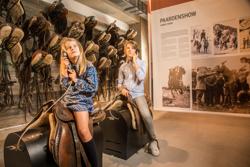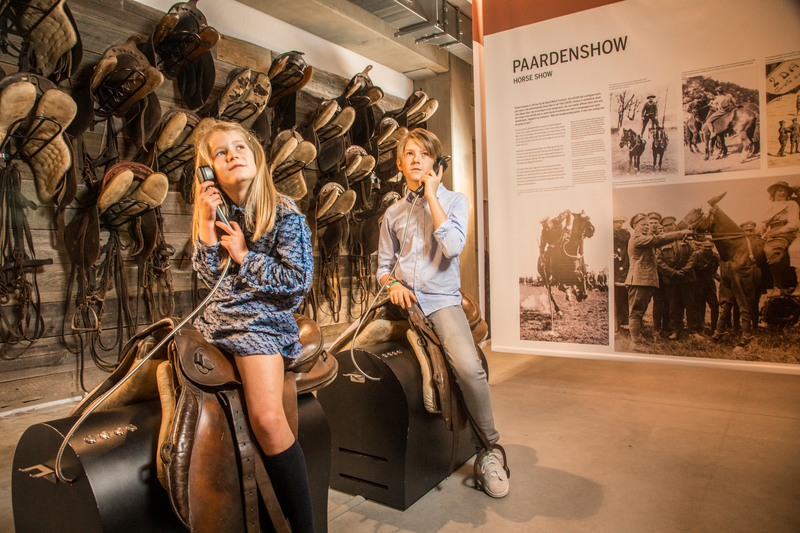The general tour takes you to the most important historical sights in Flanders Fields. Start your journey at the Memorial Museum Passchendaele and the surrounding park. Visit military cemeteries, the In Flanders Fields Museum, Talbot House, the Yser Tower, the Menin Gate and other points of interest. The tour gives you the opportunity to make the most of your 48 hour visit to Flanders Fields.
Day 1
Memorial Museum Passchendaele 1917
Berten Pilsenstraat 5a, Zonnebeke
Start the day at the heart of the Third Battle of Ypres or ‘Passchendaele’as it is more commonly known. The name alone is a symbol of senseless military violence and so the museum seeks to provide a reminder for future generations. The dugout tunnel with communication and dressing post, headquarters, workplaces and dormitories, provides an idea of how the soldiers had to live underground, like moles, because there was nothing left above. It’s impressive, as is the museum with its collection of historical artefacts,images, movies and dioramas. Complete your visit to the museum outside in the trenches before heading into the park that surrounds the museum.
Tyne Cot Cemetery
Vijfwegestraat, Zonnebeke
With its arched wall and colonnades in white stone, the Missing Memorial of Tyne Cot Cemetery instils respect. This is the largest military cemetery of the Commonwealth in continental Europe. Almost 12,000 soldiers are buried here. 12,000 white crosses, row after row. We stand in awe. On the Memorial Wall are the names of the 34,957 soldiers who fell after 16th August 1917 and whose graves are not known. In silence, we move on to another cemetery, this time on the other side of the front.
German Military Cemetery
Klerkenstraat, Langemark
Drive 4 miles from Passchendaele to the village of Langemark, where one of only four German war cemeteries in Flanders, can be found. Behind the monumental entrance lie more than 44,000 soldiers, half of them in a mass grave. Among them, are over 3000 cadets and student volunteers, which explains why the cemetery is also known as the Studentenfriedhof. The bronze statue of four grieving soldiers, by Emil Krieger, is very impressive. Slightly larger than life it immediately captures the eye, on entering the cemetery.
In Flanders Fields Museum
Grote Markt 34, Ieper
In Ypres, start with a visit to the hub of the WWI commemoration in Flanders Fields - the In Flanders Fields Museum. Entry is with a white bracelet with a red poppy on it, instead of a ticket. This museum - located in Ypres’ impressive Cloth Hall - focuses on personal stories reminiscent of the invasion, the trench war and the remembrance ceremonies since the armistice. Take time to slowly climb the belltower to have a look at what were once the battlefields.
Menin Gate
Menenstraat, Ieper
Take time to sample Flemish cuisine and the local beer before heading to the Menin Gate - by far the most famous Commonwealth war memorial in Flanders. On its white walls are engraved the names of 54,896 soldiers whose bodies were never found (the other 34,000 names we already saw at Tyne Cot Memorial this afternoon). Since 1928, each and every day, apart from the Second World War, the Last Post is sounded just outside these
The Last Post
Menenstraat, Ieper
At the end of the day, this final experience is very emotive. The four buglers - in the uniform of the voluntary fire-fighters of Ypres - stand in line and the first notes sound like a call. If we can’t call the soldiers back to life, let’s send them “a final farewell at the end of their earthly labours and at the onset of their eternal rest”, as it reads on www.lastpost.be. There are many video clips of the ceremony on YouTube but as one comment on the videos says: “You must see this once in your life. If you are not moved by it, you’re made of concrete.”
Day 2
Talbot House
Gasthuisstraat 43, Poperinge
Death cells
Stadhuis, Guido Gezellestraat 1, Poperinge
Lijssenthoek Military Cemetery
Boescheepseweg, Poperinge
The Yser Tower
IJzerdijk 49, Diksmuide
Trench of death
Ijzerdijk 42, Diksmuide
Tip: walk up to the second floor of the visitor’s centre for a panoramic view of the Yser plain.
Vladso German Military Cemetery
Houtlandstraat 3, Vladslo
Dead sons were mourned over by both sides and at the German war cemetery in Vladslo, near Diksmuide, is a symbol of this grief. Stand in front of the world famous sculpture by Käthe Kollwitz, “The Grieving Parents’ and you will see the father struggling to contain his emotion, the mother bowed in utter pain. Their son, Peter Kollwitz, age 18, volunteer in the German army lies amongst the 25,000 German soldiers burried here.


